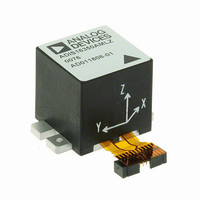ADIS16350AMLZ Analog Devices Inc, ADIS16350AMLZ Datasheet - Page 20

ADIS16350AMLZ
Manufacturer Part Number
ADIS16350AMLZ
Description
MOD TRI-AXIS GYRO/ACCEL 24-LEAD
Manufacturer
Analog Devices Inc
Series
iSensor™r
Datasheet
1.ADIS16350PCBZ.pdf
(24 pages)
Specifications of ADIS16350AMLZ
Output Type
Digital - SPI
Sensor Type
Gyroscope and Accelerometer
For Use With
ADIS16350/EVALZ - KIT EVAL TRI AXIS INTERTL SENSORADIS16350/PCBZ - BOARD EVAL FOR TRI GYRO ACCEL
Lead Free Status / RoHS Status
Lead free / RoHS Compliant
Other names
Q3366721
ADIS16350/ADIS16355
Status Conditions
The STATUS register contains the following error condition flags:
alarm conditions, self-test status, overrange, SPI communication
failure, control register update failure, and power supply range
failure. See Table 30 and Table 31 for the appropriate register
access and bit assignment for each flag.
The bits assigned for checking power supply range and sensor
overrange automatically reset to 0 when the error condition
no longer exists. The remaining error flag bits in the STATUS
register require a read to return them to 0. Note that a STATUS
register read clears all of the bits to 0. If any error conditions
remain, the bits revert to 1 during the next internal output
register update cycle.
Table 30. STATUS Register Definition
Address
0x3D, 0x3C
Table 31. STATUS Bit Descriptions
Bits
[15]
[14]
[13]
[12]
[11]
[10]
[9]
[8]
[7:6]
[5]
[4]
[3]
[2]
[1]
[0]
Description
X-axis accelerometer self-diagnostic error flag
Z-axis accelerometer self-diagnostic error flag
X-axis gyroscope self-diagnostic error flag
Alarm 2 status
Alarm 1 status
Self-test diagnostic error flag
Sensor over range (any of the six)
SPI communications failure
Control register update failed
Power supply in range above 5.25 V
Power supply below 4.75 V
Y-axis accelerometer self-diagnostic error flag
Z-axis gyroscope self-diagnostic error flag
Y-axis gyroscope self-diagnostic error flag
Not used
1 = failure, 0 = passing
1 = failure, 0 = passing
1 = failure, 0 = passing
1 = failure, 0 = passing
1 = failure, 0 = passing
1 = active, 0 = inactive
1 = error condition, 0 = normal operation
1 = error condition, 0 = normal operation
1 = error condition, 0 = normal operation
1 = error condition, 0 = normal operation
1 = above 5.25 V, 0 = below 5.25 V (normal)
1 = below 4.75 V, 0 = above 4.75 V (normal)
1 = failure, 0 = passing
1 = active, 0 = inactive
Default
0x0000
Format
N/A
Access
Read only
Rev. B | Page 20 of 24
Alarms
Two independent alarms provide programmable condition
monitoring. Event detections occur when output register data
meets the configured conditions. Configuration options include the
following:
•
•
•
•
•
The ALM_MAG1 register and the ALM_MAG2 register both
establish the threshold level for detecting events. These registers
take on the format of the source data and provide a bit for
establishing the greater than/less than comparison direction.
When making dynamic comparisons, the ALM_SMPL1 register
and the ALM_SMPL2 register establish the number of averages
taken for the source data as a reference for comparison. In this
configuration, each subsequent source data sample is subtracted
from the previous one, establishing an instantaneous delta. The
ALM_CTRL register controls the source data selection, static/
dynamic selection, filtering selection, and digital input/output
usage for the alarms.
The rate of change calculation is
where:
N
ALM_SMPL2.
y(n) is the sampled output data.
M
ALM_MAG2.
Y
C
DS
C
is the factor to compare with M
is the magnitude for comparison in ALM_MAG1 and
is the number of samples in ALM_SMPL1 and
All output data registers are available for monitoring as the
source data.
The source data can be filtered or unfiltered.
Comparisons can be static or dynamic (rate of change).
The threshold levels and times are configurable.
Comparison can be greater than or less than.
Y
Y
The
C
C
with
=
rate
N
1
DS
M
of
n
C
N
∑
change
DS
=
according
1
y
(
n
+
alarm
) 1
−
to
y
(
n
is
the
)
determined
ALM_MAG1
C
.
by
comparing
/ALM_MAG2
s
ettings












